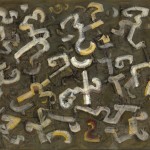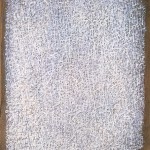Mark Tobey

Born December 11, 1890 in Centerville, Wisconsin, Mark Tobey was a painter, composer and a poet. His experimentation with abstract painting and calligraphy had a tremendous impact on future art movements, particularly Abstract Expressionism.
Tobey began his studies at the Art Institute of Chicago in 1906. He moved to New York in 1911 and worked as an illustrator for McCall’s magazine. He also worked as a portraitist for a short time to earn extra money. While posing for the artist Juliet Thompson, Tobey came upon Bahai literature and accepted an invitation to learn more about Eastern spirituality and philosophy. In 1918 he converted to Bahaism which would greatly influence his work and lead him to explore spirituality in art.
Click here to continue reading this biography
In 1922 Tobey moved to Washington where he worked as an art instructor for the Cornish School in Seattle. He later met the Chinese artist Teng Kuei who would introduce him to Eastern penmanship resulting in Tobey’s exploration of Chinese calligraphy.
In 1925 Tobey took a trip to Europe which would be the start of the extensive traveling that would play an important role in his life. He stayed in Paris for a while where he met Gertrude Stein and was introduced to the European art movements of the period. He then traveled east to Turkey, Lebanon and on to what is now Israel where he studied Arabic and Persian calligraphy.
Tobey returned to Washington in 1927 where he co-founded the Free and Creative Art School in Seattle. In 1928 he held his first one-man exhibition in Chicago, Illinois. In 1929 he had a show at Romany Marie’s Cafe in New York that marked a dramatic change in his life. It was at that show that where he met Alfred H. Barr, Jr., a curator at the Museum of Modern Art who selected several of Tobey’s works to be included at an exhibition entitled “Painting and Sculpture by Living Americans” which opened in 1930.
He traveled to England later that year where he taught art at the Dartington Hall School in Devonshire from 1930 through 1937. During that time he traveled to Mexico in 1932 and then to Japan where he studied Zen, Hai-Ku poetry and calligraphy. The influence of these trips can clearly be seen in his paintings.
Due to the deteriorating political situation in Europe, Tobey returned to the United States in 1937 and settled in Seattle, Washington. In 1944 he introduced his “White Writing” paintings for the first time at the Willard Gallery in New York. It has been said that this exhibition marked his breakthrough as an artist. His process of covering the canvas with several layers of light colored paint marks the beginning of the “all over” painting technique which would subsequently be adopted by other artists, most notably Jackson Pollock.
Mark Tobey’s paintings have since been exhibited in galleries and museums all over the world. His work is considered to be an important precursor of the Abstract Expressionist movement that began in America during the 1940’s. His first retrospective was held at The Smithsonian Institute in 1974.
Mark Tobey moved to Basel, Switzerland in 1969 where he lived until his death on April 24, 1976.
- Phtograph of Mark Tobey
- Hidden laughter – 1950
- Space Ritual XIX – 1957
- Autumn Field – 1957
- Advance of History – 1964
- Night Celebration II – 1971






